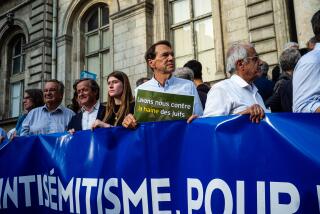Gerona’s Medieval Jewish Quarter
- Share via
GERONA, Spain — Spain will mark the 500th anniversary next year of three epochal events: In 1492, Columbus, under Spanish sponsorship, discovered (at least for the European world) the Americas; Catholic forces captured Granada, thus heralding the final defeat of the Moors (who had first entered Spain nearly 800 years before), and an edict issued by King Ferdinand and Queen Isabella ordered the expulsion from the country of all Jews who refused to be baptized into Christianity.
The medieval town of Gerona, between Barcelona and the French border in the northeastern Spanish region of Catalonia, is surely one of the best sites to feel and understand the meaning of that last cruel act.
The edict issued by the king and queen of Spain against the Jews destroyed a prosperous, educated community. It also emboldened the terrible Inquisition, which Isabella had inaugurated 14 years earlier, to hunt down Christian converts who might be backsliding into Judaic ways, and infused modern Spain with a sense of anguish and confusion about the Jews.
In anticipation of the anniversary of the edict, Spain has already bestowed its highest honor--the Prince of Asturias award--collectively on the world’s Sephardic Jews (those descended from the Jews who once lived in Spain). And a host of seminars and museum exhibits relating to the expulsion have been planned throughout the country for 1992.
Despite the expulsion and the Inquisition, the era in which Judaism thrived in Spain has always occupied a romantic place in Jewish history, and many Jewish visitors are expected to visit Spain during the anniversary year.
Toledo, just south of Madrid, where two dormant synagogues still exist, is an obvious destination for the traveler interested in the remains of Jewish life in Spain--as is Cordoba in Andalusia, which maintains a tiny active synagogue and a statue of Maimonides, the Jewish philosopher. But the lesser-known Gerona may not be on most itineraries.
Yet Gerona’s old Jewish quarter--known as the Call, a name derived from the Catalan word for “narrow passageway”--may give a better sense than Toledo or Cordoba of the atmosphere of medieval Jewish life.
Gerona--called Girona on Catalan-language maps--is an ancient town whose hills crowded with medieval stone houses turn into a wondrous vista when viewed from the footbridges on the Onyar River.
The town is only an hour’s drive from Barcelona--where the 1992 Summer Olympic Games will be held--on the A-7 superhighway going north to France. (Barcelona itself has a few relics of its own medieval Call in the Gothic Quarter.)
A visit to Gerona could be combined on a day’s trip from Barcelona with an excursion to the Salvador Dali Museum in nearby Figueres. Or it could be an afternoon’s outing from a stay in one of the secluded Mediterranean villages such as Cadaques or Llafranch on Spain’s Costa Brava.
In the middle ages, the Jews of Gerona lived in the heart of the town on the slope leading to the Cathedral of Santa Maria. The Call was a maze of narrow walkways, arched passageways, alleys and steep staircased streets that twisted past houses with stone walls and wrought-iron windows. As persecutions mounted from the late 13th Century onward, the Jews--who numbered a little more than 300--withdrew into the maze of these close streets.
Although not every street and building in the area now dates from that era, much of the Call’s medieval atmosphere has been preserved, and deep feelings stir as you make your way through a neighborhood infused by centuries of troubled history. It is a clip-clop walk on stones through dark and cooling shadows.
The Carrer de la Forca, the main street of the Call, takes most tourists to Gerona’s spacious Cathedral of Santa Maria, with its Tapestry of the Creation. In 1975, the Gerona town council reopened the Carrer de Sant Lorenc, a steep alley that had been blocked at Forca for decades. (Other blocked passage ways are due to be reopened in the next few years.)
Now, tourists may detour before reaching the cathedral and climb about halfway up Lorenc to an unnumbered door that opens into the Isaac El Sec (Catalan for Isaac the Blind) Center.
Local historians believe that a synagogue, a kosher butcher’s shop and ritual baths once occupied some of the site, but local diggers have uncovered no remnants except a few blocks of granite that once may have been part of an altar.
No matter. The building that houses the center has been restored to show how the old medieval walls of the Call hid a web of interlocking rooms and lovely flowered patios.
The center distributes pamphlets about the Jews of Gerona and of Catalonia, displays several artifacts and stones with Hebrew inscriptions (there also is a collection of Hebrew tombstones in the archeological museum in the monastery of Sant Pere de Galligants, near the cathedral), and exhibits a set of well-illustrated placards that describe the history of Catalonia’s Jews in Spanish, Catalan and English.
Isaac the Blind, a 12th-Century Kabbalah mystic, may have lived on or near the site of the center, but he was not the most famous Jew produced by Gerona. That honor surely belongs to Moses ben Nahman, the philosopher known in Hebrew as Nahmanides and by Catalans as Bonastruc da Porta.
Nahmanides, a medical doctor and the foremost rabbi of his day, was forced to take part in an historic religious disputation convened in Barcelona in 1263 by King Jaime I of Aragon.
The Catholic clergy had pressed for the contest because they believed they could convert the Jews by persuading them that passages of the Talmud verified the teachings of Christianity. Nahmanides debated the issue for four days with a convert known as Pablo Christiani. “I have never seen a man defend a wrong cause so well,” the king told the 65-year-old Nahmanides when the debate had drawn to a close.
The debate had a tragic footnote: Although the king had guaranteed Nahmanides complete freedom of speech in defending his beliefs, Pope Clement IV demanded that the rabbi be punished for composing “a tract full of falsehood concerning his disputation” and circulating “copies of the book in order to disseminate his erring faith.” Banished from Catalonia in 1267, Nahmanides left Gerona for Jerusalem, where he died three years later.
Bowing to the pressures of militant proselytization, pogroms and the edict of expulsion, a large number of Jews in Gerona (as in the rest of Spain) converted to Christianity. But these new Christians, accused of insincerity in their conversion or of having relapsed secretly into Judaism, became the main target of the Inquisition.
Between 1491 and 1505 alone, 84 converted Gerona Jews were put on trial by the Inquisition, and many of them were executed. (The Spanish Inquisition also tortured and executed Moorish converts suspected of backsliding into Islam.)
When Spaniards talk about Jews these days, they usually mean descendants of “new Christians” rather than the dispersed Sephardic Jews or the few thousand Jews who have emigrated to Spain in the 20th Century. As a result, Gerona is still thought of as a “Jewish” town even though almost everyone living there has been baptized a Catholic.
A Spanish-Israeli commission, created for the 500th anniversary, has announced plans to open a new Jewish museum in Gerona in 1992. While located in the Call, it will be separate from the Isaac El Sec building, which will serve as a Jewish cultural center.
GUIDEBOOK
Gerona, Spain
Getting there: Gerona is about 60 miles north of Barcelona on the A-7 superhighway leading to the French border, and about the same distance from Perpignan, across the border in France. (Note that a new Spanish law requires visitors who drive in that country to carry an international driver’s license.) There also is frequent train service to Gerona from Barcelona.
Where to stay: Because it is so close to Barcelona, there is no need to plan an overnight stay in or near Gerona. If you choose to do so anyway, the selection in the city itself is modest. The Ultonia, Gran Via de Jaume I 22, from U.S. telephones 011-34-72-20-38-50, and the Costabella, Avinguda de Francia 61, 011-34-72-20-25-24, offer simple accommodations for about $60 a night for two.
In Figueres (home of the Dali Museum), the Hotel Ampurdan, Carretera N-11, 011-34-72-50-05-62, offers nicer rooms in the same price range--and boasts one of the best restaurants in this part of Spain (one star in the Guide Michelin).
There are numerous hotels on the Costa Brava, most 30-40 miles from Gerona, including: the small, elegant Carles Camos/Big Rock, Barri de Fanals 5, Platja d’Aro (Playa de Aro), 011-34-72-81-80-12, about $200 a night for two (also with a Michelin one-star restaurant); the exquisitely situated Parador de la Costa Brava, Playa de Fornells, Aigua Blava, 011-34-72-62-21-62, about $110 a night for two, and the posh Hostal de la Gavina, Placa de la Roselada, S’Agaro, 011-34-72-32-11-00 (also member Leading Hotels of the World, call U.S. reservation number: 800-223-6800), about $250 a night for two.
Where to eat:
In Gerona: For Catalan food, try Bromsom’s, Avinguda Sant Francesc 7, local telephone 21-24-93; Hostalet d’el Call, Carrer Batlle i Prat 4, 20-71-53, and Mas El Moli, Carretera N-11, 21-38-48--all about $40-$60 for two, including local wine.
Within 30 miles: The Hotel Ampurdan, Figueres; Carles Camos/Big Rock, Platja d’Aro (see above); Sa Punta, Playa de Pals, 63-64-10, and Eldorado Petit, Rambla Vidal 23, Sant Feliu de Guixols, 32-18-18, the original of the famous restaurant of the same name in Barcelona (now also open in New York).
For a serious gastronomic adventure on the way back to Barcelona: El Raco de Can Fabes, Carrer Sant Joan 6, Sant Celoni, 011-34-3-867-28-51. One of the few restaurants in Spain awarded two Michelin stars, it creates such truly original dishes as scorpion fish in vinegar sauce with wild turnips.
More to Read
Sign up for Essential California
The most important California stories and recommendations in your inbox every morning.
You may occasionally receive promotional content from the Los Angeles Times.












